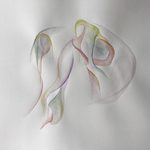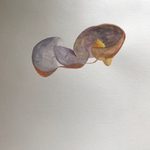
While painting these abstract, large-scale watercolors, I consider where each line leads and how each form interacts with its neighbors. Some forms hold others while some hug or just reach and lightly touch. The medium’s easy access to ranging opacity adds options here: transparent curtains or webbing connect forms while veiling those in between and transparent bodies hold others completely inside, referencing imagery of an ultrasound. Using these means, I ensure all forms are in conversation with one another.
My influences include Wassily Kandinsky, Christina Quarles, and Georgia O’Keeffe. All treat form and color with boldness. Kandinsky’s lines and forms bump against one another, energizing the space and creating visual interest. Some of his paintings use positive and negative space selectively towards this effect. Quarles uses a full range of color saturation in her paintings of intertwining bodies to seduce the viewer. The color is often saturated at the edge of a form and many transparent gradients are layered throughout. O’Keeffe uses saturated color gradients as well to smooth out flowers and landscapes, resulting in elegant, alluring paintings.
I draw from these painters to ultimately accomplish my goal of drawing in viewers, getting them to pay attention and spend time with the paintings. Color can easily grab attention while visual paths through the painting attempt to sustain attention.
I then use video to ensure this. Just by watching, the viewer spends the duration of the video with the painting, looking close up. The video follows these visual paths built into the painting, explicitly leading the viewer through. This format of viewing the painting essentially slows down and enhances the task typically presented to the viewer of a two-dimensional image, of running their eyes through the image.
This restriction becomes a metaphor in that we can only observe and act one moment at a time, unable to view our lives all at once. In Slaughterhouse-Five by Kurt Vonnegut, when Billy Pilgrim is abducted by the creatures of Tralfamadore who experience life in four dimensions, he asks:
-Why me?
-That is a very Earthling question to ask, Mr. Pilgrim. Why you? Why us for that matter? Why anything? Because this moment simply is. Have you ever seen bugs trapped in amber?
-Yes.
-Well, here we are, Mr. Pilgrim, trapped in the amber of this moment.
With our literally limited perspective, it is easy for Billy to get caught up in this useless question. While we can’t choose which moment to look at when, in time we are given the opportunity to look at each one closely. The slow pace of the videos is appropriate for this meditation.
As for the implication of starting with an abstract composition, I heighten the element of fiction by more directly engaging the viewer. It is not obvious what the videos are of; they read as a sort of fictional landscape being travelled through. This sensation is enhanced with different viewing angles of the paper which viewers don’t typically choose to experience. I ask the viewer to temporarily join a world I’ve created, to pay close attention, and then hopefully to continue to pay attention after they leave, looking for chances to materialize beautiful fictions.
— Celeste Gaughan ’20
Video of Watercolor, 2020
Video (recommended view in full screen)



